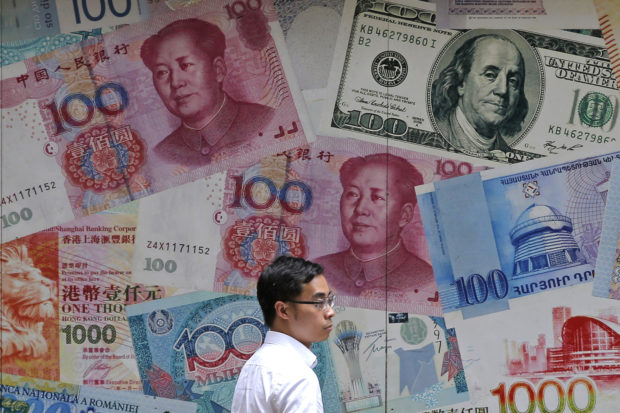BEIJING – China’s yuan fell below the politically sensitive level of seven to the U.S. dollar on Monday, possibly adding to trade tension with Washington.

FILE – In this June 10, 2019, file photo, a man walks past a money exchange shop decorated with different banknotes at Central, a business district of Hong Kong. China’s yuan fell below the politically sensitive level of seven to the U.S. dollar on Monday, Aug. 5, 2019, possibly adding to trade tension with Washington. The currency weakened to 7.0177 in early trading following U.S. President Donald Trump’s threat last week of tariff hikes on additional Chinese imports in a fight over Beijing’s trade surplus and technology policies. (AP Photo/Kin Cheung, File)
The currency weakened to 7.0177 in early trading following President Donald Trump’s threat last week of tariff hikes on additional Chinese imports in a fight over Beijing’s trade surplus and technology policies.
The yuan’s weakness is among a series of U.S. complaints that are fueling tensions with Washington. American officials complain a weak yuan makes China’s exports too inexpensive, hurting foreign competitors and swelling Beijing’s trade surplus.
The level of seven yuan to the dollar has no economic significance, but could revive U.S. attention to the exchange rate.
Trump’s tariff hikes have put downward pressure on the yuan by fueling fears economic growth might weaken.
The U.S. Treasury Department declined in May to label China a currency manipulator but said it was closely watching Beijing.
Chinese leaders have promised to avoid “competitive devaluation” to boost exports by making them less expensive abroad. But regulators are trying to make the state-controlled exchange rate more responsive to market forces, which are pushing the yuan lower.
The yuan, also known as the renminbi, or “people’s money,” has lost 4 percent since hitting a high in February of 6.6862 to the dollar.
That helps exporters cope with tariffs of up to 25 percent imposed by Trump on billions of dollars of Chinese goods. But it raises the risk of inflaming American complaints.
Trump rattled financial markets Thursday by announcing plans for 10% tariffs on $300 billion of Chinese goods, effective Sept. 1. That would extend penalty duties to almost all U.S. imports from China.
China’s central bank sets the yuan’s exchange rate each morning and allows it to fluctuate by 2 percent against the dollar during the day. The central bank can buy or sell currency — or order Chinese commercial banks to do so — to dampen price movements.
The Treasury report in May said U.S. authorities believe direct central bank intervention this year “has been limited.” However, it urged Beijing to “take the necessary steps to avoid a persistently weak currency.”
A weaker yuan also might disrupt Chinese efforts to shore up weakening economic growth by encouraging an outflow of capital from the world’s second-largest economy. That would raise borrowing costs.
The central bank tried to discourage speculation last August by imposing a requirement that traders post deposits for contracts to buy or sell yuan. That allows trading to continue but raises the cost. /gsg

